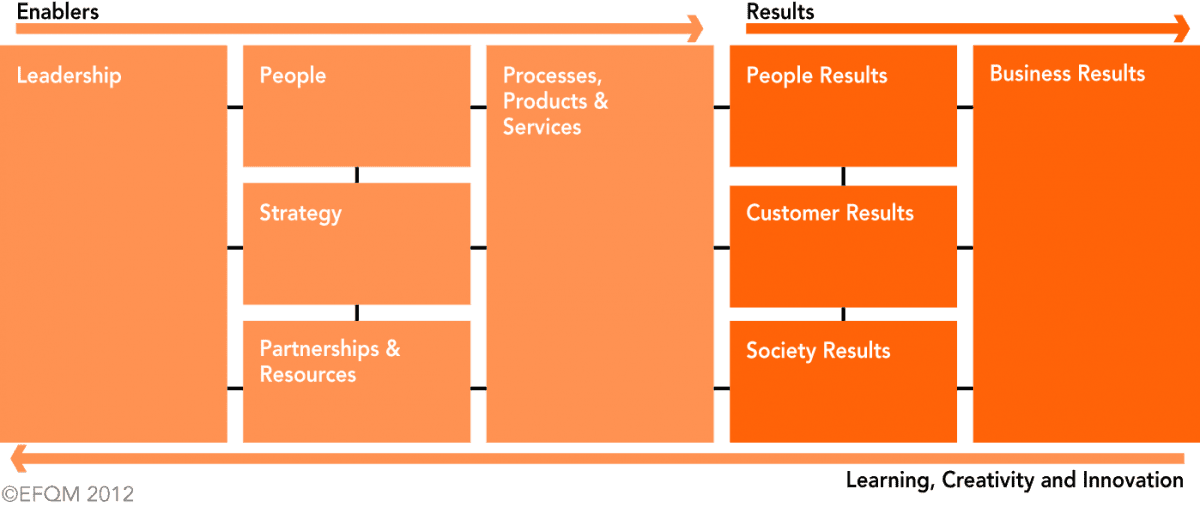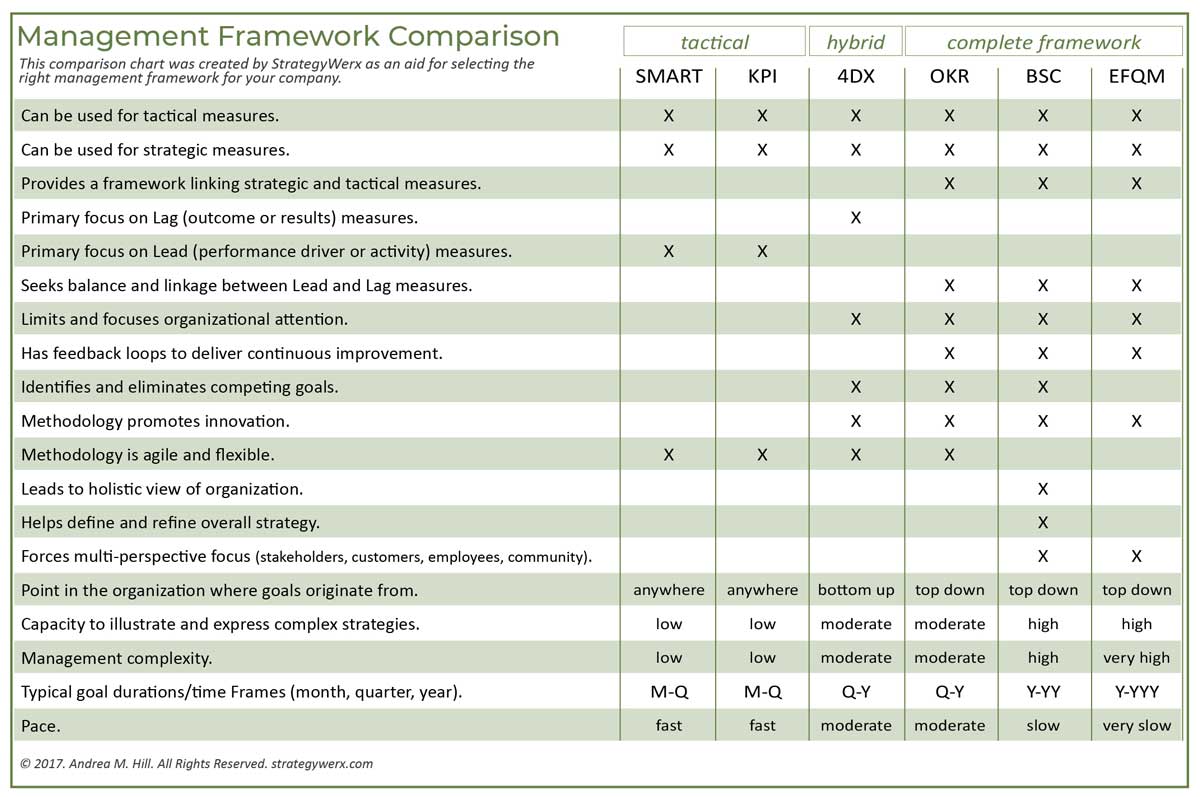So you've done the work of coming up with a business strategy, a minimum viable product or service, and a business plan. Now what? Well, for a company to achieve its strategy and operate effectively, it must have goals, measurable objectives, and a method of monitoring and managing results; in other words, a Management Framework.
What is a Management Framework?
Management Frameworks are the tools used by the most competitive companies to turbo-charge innovation, harness energy, and align people, teams, and divisions. Without a management framework, companies function at a tactical level at best. Think of them as systems that facilitate setting and managing measurable goals and objectives that are linked to an organization's strategy. The best frameworks make it possible for a large group of people to see the strategic vision of a company in a similar way, orient themselves and their work to achieve the strategic vision, remain in alignment with one another even when working independently, and consistently improve their performance and renew their focus relative to strategy.
There is no perfect management framework, but there are several excellent ones. It’s important to understand how each system works, and which framework to apply to specific companies, cultures, or situations. Some of these systems also work well in tandem, offsetting each other’s weaknesses with complementary strengths.
The two most frequently used systems for performance measurement are SMART goals and KPIs. Unfortunately, these are also the two weakest measurement approaches, best used as the tactical component of a more holistic strategic framework.
The two most used management frameworks are Balanced Scorecard (BSC) and Objectives & Key Results (OKR). Two other frameworks, 4DX and EFQM, also merit consideration when determining which management framework to adopt.
Let’s start with a comparison table, then look at the basics of each metric system and management framework.
Now let's do a high-level overview of each system.
KPI - A Measurement Approach
The most well-known metrics strategy, KPI is also the narrowest. KPI stands for Key Performance Indicator, which can be any performance metric for any business outcome or activity. A KPI can be a Lag indicator (an outcome measure — an indicator of past performance that measures the result), a Lead indicator (a performance driver — something you monitor or measure to determine if you are making progress toward a goal), or a Tactical measure (a short range, operational, or immediate metric, like a machine temperature or daily staffing level). It can measure success, output, quantity, quality, or time.
KPIs are most effective when used within a management framework, such as Balanced Scorecard, OKR, EFQM, or 4DX. On their own, KPIs can be useful, but they can also be suboptimizing and create conflicting focus between teams and departments.
SMART Goals - A Goal-Setting Method
Like KPIs, SMART Goals are a measurement type, not a management framework. Smart Goals are a popular goal-setting technique that focus on creating effective goals. There are no mechanisms within SMART Goals to drive alignment within an organization, and no guarantee that any particular goal will lead to innovation. SMART goals are a criteria, not a framework or system.
SMART Goals can be Lag or Lead indicators, and can be created at any level of an organization.
According to SMART criteria, there are five things that a goal must be:
- Specific
- Measurable
- Achievable
- Relevant
- Time-bound
4DX - A Prioritization and Measurement Method
Created by Stephen Covey and Chris McChesney, this is system is a hybrid; part measurement method, part management framework. It is designed to create:
- Focus
- Leverage
- Engagement
- Accountability
This system proposes to help managers and employees cut through the constant flurry of tasks and shifting priorities, and focus on the key goals for each area. Key concepts of this system include:
- The more goals a person has to achieve, the less likely they are to focus enough to achieve any of them effectively.
- Competing priorities and goals suboptimize the organization.
- Everyone should be working on two big goals (called WIGs, or Wildly Important Goals in 4DX) at any time.
Rules of this system include:
- No team can focus on more than two WIGs at the same time.
- The battles you choose must win the war (strategic alignment).
- Senior leaders can veto, but not dictate, goals (bottom-up goal development).
- All WIGs must have date gates, in the form of “X to Y by Date” to provide clear scope.
OKR - An Agile Management Framework
Now let's start looking at true management frameworks. The first is OKR, which stands for Objective & Key Results. The OKR and Balanced Scorecard systems share a lot of DNA, and the choice between them often comes down to pace and agility. These two systems can also be used together to gain the greatest benefits of both systems.
Objectives in OKR
According to the OKR definition, an OKR consists of 1–5 Objectives which, by their nature, are qualitative concepts (characterized by their quality and difficult to measure). They provide direction, typically posed in question form:
- What do I want to accomplish?
- Where do I want to go?
The purpose of objectives is to provide the definition for the goal(s) you want to pursue. These are most often Lag, or Outcome measures.
The characteristics of OKRs should be:
- Directed
- Aligned
- High in impact power
- Easy to understand
- A means of inspiration
Key Results in OKR
Each of the 1–5 Objectives should have from 3 to 5 Key Results (these need to be quantitative concepts and must be measurable). If it’s not measurable, it’s not a key result.
The purpose of Key Results is to define the measurements that will determine if the organization (team, individual) is progressing toward the objective. Key results are milestones, and answer the questions:
- How will we know when we get there?
- How will we accomplish that?
Key Results can be a combination of Lag (Outcome) and Lead (Performance Driver) metrics, and should be:
- Easily measurable
- Specific
- Bound to a specific time frame
Initiatives in OKR
Each of the 3 to 5 Key Results may also be linked to specific initiatives meant to define the work needed to maintain progress on the Key Results. They are specific actions and activities. There is a minimum of 1 Initiative related to a specific OKR.
Initiatives answer the question:
- What must we do in order to get there?
Initiatives are almost always Lead (Performance Driver) measurements, and should be:
- Easily measurable
- Specific
- Controllable
- Bound to a specific time frame
Want to learn more? Buy the definitive guide on OKR and support an independent bookseller! Order "Measure What Matters" here.
Balanced Scorecard - A Holistic Management Framework
The Balanced Scorecard is a management framework developed by Robert Kaplan and David Norton. It is a strategic method designed to align all areas of an organization with corporate strategy, and to drive awareness of what a business must do for customers, excel at internally, and invest and develop in order to achieve its strategic goals.
It is the strongest framework for eliminating competing goals, mitigating suboptimization between departments or functions, and ensuring holistic business goal-setting. It is also one of the best frameworks for driving innovation, due to the unique framework of the Four Perspectives.
Four Perspectives Framework
The framework of the Balanced Scorecard is built on four perspectives:
- Financial Perspective: What must we do for our stakeholders in order to be successful? These are Lag measures.
- Customer Perspective: What must we do for our customers, in order to achieve our financial goals? These are generally Lag measures, but can include Lead measures as well.
- Internal Perspective: What must we excel at, internally, in order to achieve our customer goals? These are typically Lead measures.
- Learning & Development Perspective: What must we learn, invest in, develop, or acquire in order to achieve our Internal goals? These are typically Lead measures.
Balanced Scorecard implementations are often complex, but it can be implemented in a very lean manner. If complexity is the one reason you’re concerned about using a Balanced Scorecard in your business, dig a little deeper. Small businesses can implement Balanced Scorecards successfully using a lean approach (I call it a “Skinny Scorecard”). One of the best ways to reduce the complexity of the Balanced Scorecard is to combine it with an OKR approach, which keeps the richness of the Balanced Scorecard perspectives while benefitting from the agility of the OKR method.
Learn all about the Balanced Scorecard and support an independent bookseller! Order The Balanced Scorecard here.
EFQM - The Broadest Management Framework
Of all the management frameworks, EFQM (European Foundation for Quality Management) is the broadest. EFQM was founded by a consortium of European business leaders with a goal of creating a formalized management framework to help organizations become more effective, which in turn would drive overall effectiveness of the European economy. As a result, this framework reaches beyond individual organization boundaries and has a strong social component. The idea is that using the EFQM Excellence Model helps organizations understand where they are on a “path to excellence,” while giving them tools and techniques to measure improvement over time.
In the EFQM model there are “enablers” and “results.” It is sometimes thought that Enablers are similar to Lead measures, and Results are similar to Lag measures, but the model is a bit more nuanced than that.
Here is how the model is most often illustrated:

EFQM Concepts
Enablers include:
- Leadership
- People
- Strategy
- Partnerships and Resources
- Processes, Products, and Services
The idea is that by changing what any of these enablers do, you can change the results of the organization.
Results are the goal, with specific principles in mind:
- People Results
- Principle: Leading to inspiration and integrity.
- Principle: Succeeding through the talent of people.
- Customer Results
- Principle: Adding value for customers.
- Society Results
- Principle: Creating a sustainable future.
- Business Results
- Principle: Developing organizational capability.
- Principle: Harnessing creativity and innovation.
- Principle: Managing with agility.
- Overarching principle: Sustaining outstanding results.
Managing Results
EFQM’s RADAR function is similar to Balanced Scorecard and OKR in so far as it requires the planning and development of “approaches” to describe how each “result” will be achieved. Once you know what the approach will be for each goal, there is a “deployment” step that determines how, where, and when each approach will be implemented. The “Assess and Refine” element of RADAR ensures that progress is continuously monitored, learnings are captured, and the group comes to consensus on whether or not the “approach” to the “result” is working. If it is not, it is refined.
Summary
Like shoes and swimming suits, there's no such thing as a Management Framework that fits everyone perfectly. It's valuable to select the framework that fits your organizational culture, business proposition, and strategy. However, if you're choosing between spending a year to get to the right framework, or spending the year with a management framework that's not perfect, I'd definitely choose the latter. Your management framework is one of the building blocks of business success. No business is too small to have one, and no small business can become a larger, more profitable business without one.












